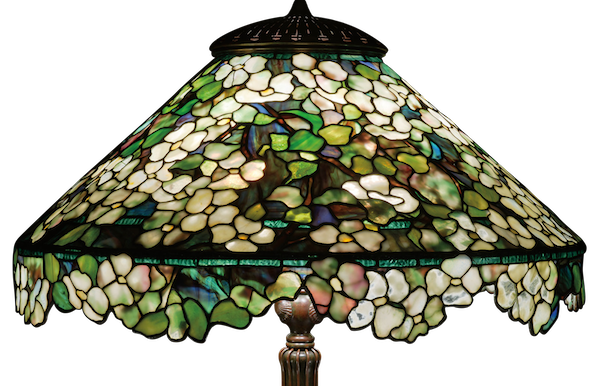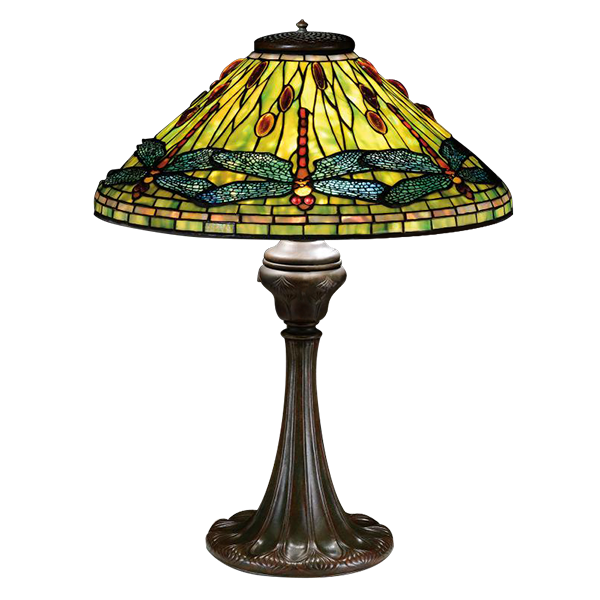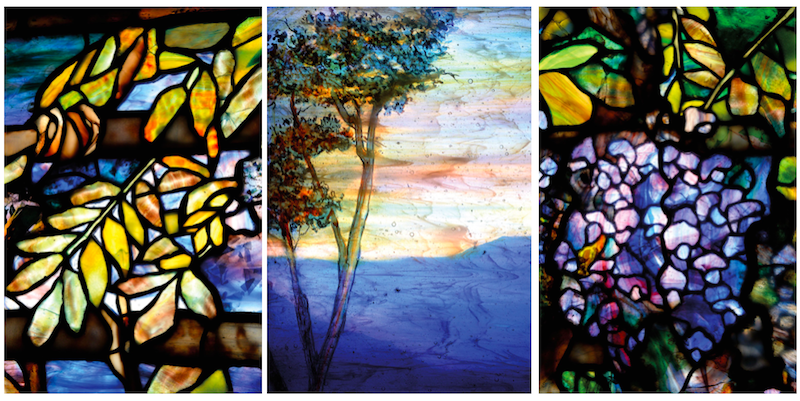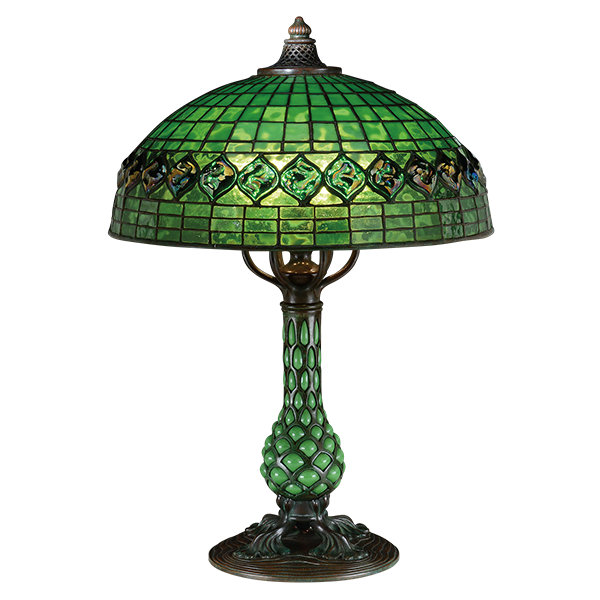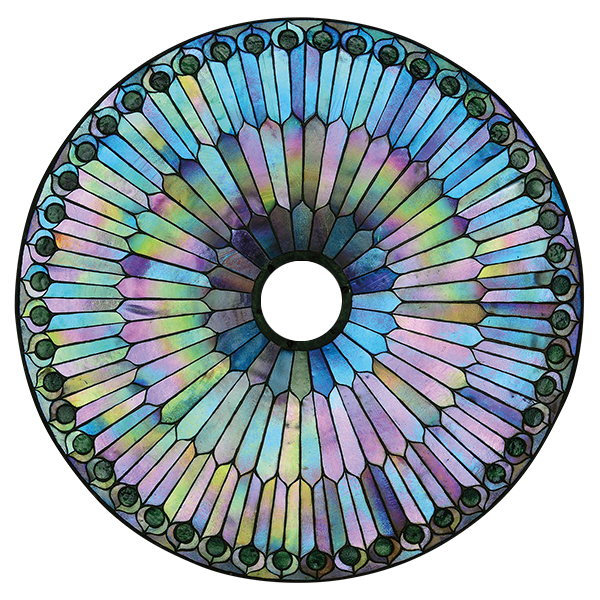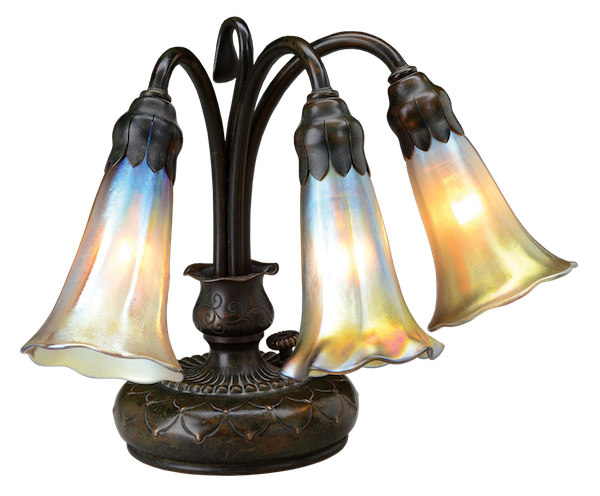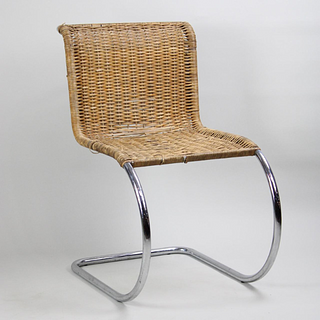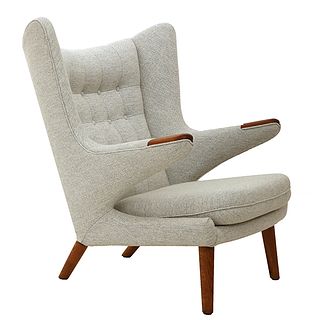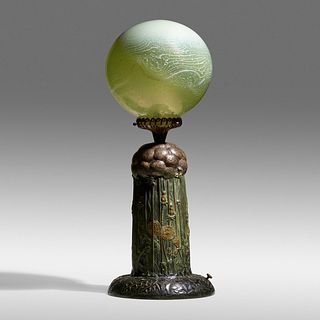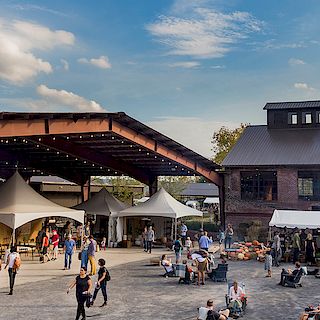Tiffany Studios: Illuminating Insights; Q & A with Mike Fredericks
Imagine crossing a dark living room, your arm blindly oscillating in search of the nearest light source...click!...you’ve switched on a marvelous patch of bending iridescent-gold tulips or perhaps you’ve ignited a flurry of cream colored dogwood flowers! What a marvelous surprise it would be to absorb the celebrated ambience of Louis Comfort Tiffany’s bronze and blown glass lamps. Louis Comfort Tiffany, the famed early 20th-century designer, known for his impressive impact on Art Nouveau, continues to shed light on master craftsmanship as the man behind some of the most desired decorative artworks in the world.
Lot 1108, Tiffany Studios Dogwood Floor Lamp, From an Unreserved Texas Estate; Image detail; Estimate $100,000 - $150,000
On June 16th, James D. Julia will present its highly anticipated, annual early summer, Extraordinary Rare Vintage Tiffany Lamps, Glass & Fine Jewelry Auction. The catalog will include an impressive breadth of Tiffany designs, many fresh to the market and offered without reserves. Featured in a variety of colors, shapes, sizes and motifs; dragonflies, acorns, apple blossoms, lotus, pansies, daffodils, mushrooms, arrowroot and wisteria, among many others - it is almost impossible to pick a favorite. We’ve plucked several luminous examples from a garden of options to ask Mike Fredericks, James D. Julias Department Head in Rare Lamps, Glass & Fine Jewelry how one can brighten their understanding when viewing or acquiring Tiffany Studios lighting fixtures.
BSQ: The advantage of browsing a broad catalog such as this, is that one can clearly separate the complex masterworks works from simpler designs (estimates help too…) Without the help of a sale catalog, what is the first element of design that one should observe when valuing a Tiffany lamp? Does size always matter?
MF: Great question! The value of a Tiffany lamp is determined by a combination of elements. Pattern rarity, glass selection, size, provenance, which base accompanies the shade, and perhaps most important is condition. The one characteristic that today’s buyers at all value levels are seeking is to find authentic examples in whichever style they prefer, that are in the best original condition possible. Regarding size, this is not always an indicator of higher value. Two shades of different size but similar pattern could have vastly different color and textures in the glass selection that could make the smaller shade considerably more valuable.
Lot 1373, Tiffany Studios Dragonfly Table Lamp; Estimate $100,000 - $130,000
BSQ: Considering the monumental skill and time it takes to produce these intricate shades and window panes, is it safe to assume that Louis Comfort Tiffany was producing a large portion of these artworks through buyer commissions?
MF: In Tiffany’s early years of leaded glass, religious and landscape themed windows were custom ordered by churches and well-to-do families for mausoleums, homes and businesses. It is highly likely that this carried over into the lamp production, with affluent buyers requesting specific colors and textures of glass using Tiffany’s established designs. A customer could also choose from a selection of shades available in the showroom, and likewise choose from a variety of bronze bases that were fit to whichever size shade they were interested in.
Lot 1365, Tiffany Studios Leaded Glass Wisteria Window; Image detail; Estimate $100,000 - $150,000
BSQ: It isn’t always about the glass! Some of the lamp bases are just as imaginative as the shades they support. How do the bases effect the value of a lamp? Are there any exciting base motifs worth noting?
MF: Just as with the glass shades, the pattern, rarity and condition can have a dramatic impact on the overall value of the lamp. Bases come in a range of complexity from simple bronze bases in the $1000 range that state uncluttered functionality, to elaborately adorned bases that are creative masterpieces that could add $50,000 to $100,000 to the lamps value. Models with more intricate or reticulated metal work, turtleback and mosaic tiles, or blown glass inserts always perform very well at auction.
BSQ: With estimates reaching upwards of $150k - these don’t strike me as ordinary home accessories (no running in the living room please!) Who do you see collecting the finer examples of Tiffany Studios fixtures? Museums? Interior Designers?
MF: Today’s buyers are an interesting mix, with the antiques trade, designers, and collectors participating at all value levels, but the top-tier of quality still seems to go to well-heeled private collectors who are passionate about the work of Tiffany and are constantly on the hunt for the next great newly-discovered treasure.
Lot 1107, Tiffany Studios Turtleback Table Lamp; Pineapple base with green blown-out glass stem and cast bronze stylized leaf feet, From an Unreserved Texas Estate; Estimate $30,000 - $50,000
BSQ: With titles such as “turtleback” and “peacock” as well as the vast array of floral motifs - it is clear that Louis Comfort Tiffany shared an admiration for and was inspired by nature. With so many styles to choose from, is there a way to deliberate the success of one motif over another? Is rarity ever considered over complexity?
MF: Tiffany was at the pinnacle of his success during the Art Nouveau movement, which was known for designs inspired by function and nature. The more elaborate floral designs from this time period are the most sought-after of Tiffany Studios lamps. Many of their simpler geometric designs are enjoyed by Arts and Crafts collectors, as well, but these are not as scarce as the complex florals. Rarity vs. Complexity are quite often one-in-the-same. Some of the most valuable and scarce patterns are the most complex that were produced and sell for a premium. For example, Model 1505 is a 22” Peony floral design that can sell for $60,000 to $200,000 or more. Model 1903 is also a 22” Peony shade, but described as ‘Elaborate’, with more complex composition, typically an exceptional glass selection, and are much harder to find. This model can sell from $200,000 to well over $1Million.
Lot 1112, Tiffany Studios Mosaic Peacock Chandelier, From an Unreserved Texas Estate; Image Detail; Estimate $40,000 - $60,000
BSQ: Did Louis Comfort Tiffany forge any of these artworks personally? When one views and/or acquires a ‘Tiffany Studios’ fixture, does that mean that he had a physical hand in its production?
MF: There has been a perception that Tiffany himself “made” his pieces because his works are so often signed, particularly his favrile glass vases which sometimes carry a full “L.C. Tiffany Favrile” or “LCT” signature. This is not necessarily the case. Louis Comfort Tiffany was initially trained as an artist, was an excellent painter and did, in fact, execute many works by his hand that have come to market over the years. However, as his career developed and glass became his medium of choice, he did what many successful business moguls do. He surrounded himself with very talented people that could transform his concepts into reality, while maintaining the mystique of being the one and only face of the company. Individual credit was not given to the employees at the time. It has since been established that Arthur Nash was the lead chemist responsible for the many detailed formulas of Tiffany’s early hand-blown glass, but in some cases did not disclose his formulas, even with Mr. Tiffany. Just a little over 10 years ago, it was verified that Clara Driscoll was the designer of many of Tiffany’s most popular lamp patterns, including Dragonfly, Daffodil, Peony and Wisteria. This was a remarkable discovery some 100+ years later, that Tiffany himself, while maintaining creative oversight, was not the actual designer of these amazing works. Equally as remarkable, was that at the turn of the century, a woman was elevated to such an important position in such a successful company, and was one of the highest paid women of her time.
Lot 1468, Tiffany Studios 3-Light Lily Lamp; Estimate $3,000 - $5,000
BSQ: The price ranges are so vast! Would you say that the lower estimated items have the potential to increase in value overtime? Any advice for young collectors?
MF: Because there are many different value levels, my advice to collectors in any of these tiers is to buy the piece that is in the best original condition that can be found, from a trusted and reputable source. It will most likely hold its value and in some cases, mature in value. Yes, the market goes in cycles with prices fluctuating, trends come and go, but authentic Tiffany will always have a following.
Click here to view all Tiffany Studios designs available at James D. Julia’s, Extraordinary Rare Lamps, Glass & Fine Jewelry Auction catalog on June 16th.
With many pieces being offered without a reserve, this sale encourages great buying opportunities! Click here to view all items from the unreserved Estate of Lynda Cunningham. Click here to view all items from the unreserved Texas Estate. Other notable highlights from the upcoming catalog include collectible brands such as Daum Nancy, Lalique, Loetz, Handel, and Pairpoint, among many others. Exceptional unreserved jewelry such as Lot 1020, a Cartier Emerald & Diamond Ring (Estimate $20,000 - $30,000) is also expected to attract significant bidding!
Click here to view the full James D. Julia, Extraordinary Rare Lamps, Glass & Fine Jewelry Auction catalog on June 16th.

Mike Fredericks, Department Head, Rare Lamps, Glass & Fine Jewelry Division
- Preview the December Doyle+Design Auction: A Celebration of Modern & Contemporary Mastery
- Billings Winter Design 2025: A Celebration of Modern Mastery Across Eras
- The Ultimate Holiday Gift Guide: Luxe Finds From Bidsquare’s Finest Auctions
- Fine & Antique Jewelry Sale: A Curated Journey Through Craftsmanship & Design
- Upcoming Auction Spotlight: Doyle’s Fine Art: 19th Century & Early Modernism
- Entertain with Style This Holiday Season: Highlights from Doyle’s December 8 Auction
- Six Standout Lots from Newel’s Fine Jewelry, Timepieces & Luxury Handbags Sale
- Artist Spotlight: Roy Lichtenstein, Pop Art’s Master of Bold Lines & Bigger Ideas
- Discover the Warmth of Pennsylvania Impressionism: Nye & Co.’s Dec. 3 Auction Features the Collection of Nancy & Robert Stein
- Inspired by Cape Cod: The Artists Who Paint Its Light, History, and Character



 EUR
EUR CAD
CAD AUD
AUD GBP
GBP MXN
MXN HKD
HKD CNY
CNY MYR
MYR SEK
SEK SGD
SGD CHF
CHF THB
THB